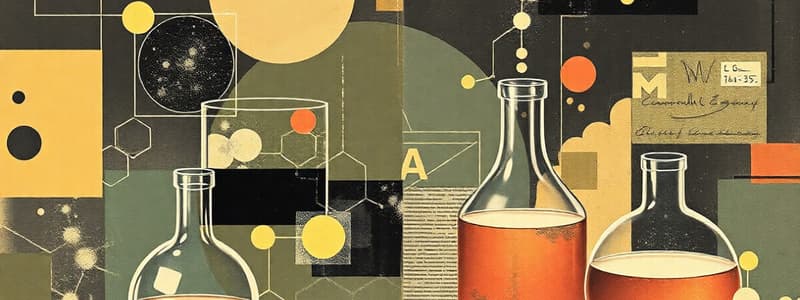Podcast
Questions and Answers
Which statement accurately describes a mixture?
Which statement accurately describes a mixture?
What happens to a system in equilibrium when more reactants are added?
What happens to a system in equilibrium when more reactants are added?
In an exothermic reaction, what is the expected effect on equilibrium when heat is released?
In an exothermic reaction, what is the expected effect on equilibrium when heat is released?
What defines the components of a chemical reaction?
What defines the components of a chemical reaction?
Signup and view all the answers
Where are protons and neutrons located within an atom?
Where are protons and neutrons located within an atom?
Signup and view all the answers
What is a key characteristic of mixtures compared to compounds?
What is a key characteristic of mixtures compared to compounds?
Signup and view all the answers
When the temperature of a system at equilibrium is increased, what effect does this have?
When the temperature of a system at equilibrium is increased, what effect does this have?
Signup and view all the answers
What occurs during a reversible chemical reaction?
What occurs during a reversible chemical reaction?
Signup and view all the answers
Which statement accurately describes nucleons?
Which statement accurately describes nucleons?
Signup and view all the answers
In terms of molecular structure, what does polarity refer to?
In terms of molecular structure, what does polarity refer to?
Signup and view all the answers
Study Notes
Compounds and Mixtures
- Compounds consist of two or more atoms that are chemically bonded together.
- Mixtures consist of particles that are not bound by chemical bonds, allowing for variable proportions.
- Mixtures do not require a chemical reaction to separate their components, enabling easy physical separation.
- Air serves as a common example of a mixture, containing various gases in unbound forms.
Molecular Structure and Chemical Reactions
- Molecules can be composed of the same type of atoms or different types, showcasing diversity in structure.
- Chemical reactions involve two main components: reactants, which form new bonds, and products, the resulting substances.
- A chemical equation visually represents the transformation of reactants into products.
- Reversible reactions allow products to revert back into reactants, demonstrating the dynamic nature of chemical processes.
- Equilibrium occurs when the rate of the forward reaction is equal to the rate of the reverse reaction.
Changes and Disturbances in Equilibrium
- Adding more reactants to a system in equilibrium can disturb the balance, resulting in a temporary imbalance.
- To counteract disturbances, a system can shift its equilibrium to restore balance.
- Removing reactants can also lead to a shift in equilibrium, reinforcing the interdependence of reactants and products.
- An increase in temperature adds energy to the system, prompting the equilibrium to shift based on the energy distribution.
Energy and Reaction Types
- Exothermic reactions release heat, affecting the position of equilibrium.
- During an exothermic reaction, the equilibrium will shift towards the reactants, reducing heat to counterbalance the added energy.
Atomic Structure and Properties
- Covalent bonds form between atoms by sharing electrons, allowing the atoms to achieve stability.
- Polarity within a molecule arises from the presence of both negative and positive charges.
- Most of an atom's volume is empty space, with protons and neutrons located in the nucleus.
- Protons and neutrons, collectively known as nucleons, determine the mass of the atom, which is concentrated in the nucleus.
- Opposite electric charges exhibit an attractive force, influencing atomic and molecular interactions.
Chemical Substances and Reactions
- Compounds consist of two or more atoms that are chemically combined.
- Mixtures include particles that are not bonded by chemical forces; they can vary in proportions.
- Mixtures do not require chemical reactions to separate into their individual components.
- A common example of a mixture is air, composed of various gases.
- Molecules are formed from atoms and can consist of the same or different types of atoms.
Chemical Reactions
- Every chemical reaction involves two main components: reactants and products.
- Reactants undergo transformations, forming new chemical bonds to create different substances.
- A chemical equation represents the conversion of reactants into products.
Reaction Dynamics
- Reversible reactions can shift back and forth between products and reactants.
- Equilibrium is a state where the forward and reverse reactions occur at equal rates.
- Adding reactants to an equilibrium system causes a temporary imbalance, prompting the system to adjust.
- Removing reactants from a system in equilibrium also triggers a shift to restore balance.
Temperature and Energy in Reactions
- Increasing the temperature in a reaction system can lead to a shift in equilibrium due to the added energy.
- Exothermic reactions release heat; during such reactions, the equilibrium typically shifts toward the reactants to reduce heat production.
Atomic Structure
- Covalent bonds involve the sharing of electrons between atoms to achieve stability.
- Polarity refers to molecules having regions with different charges, creating a positive and negative side.
- Most of an atom's volume is occupied by empty space surrounding a dense nucleus.
- Protons and neutrons reside in the nucleus at the center of the atom, referred to collectively as nucleons.
Fundamental Atomic Concepts
- The mass of an atom is primarily concentrated in its nucleus.
- Opposite electric charges exhibit an attractive force towards each other, a fundamental principle of electrostatics.
Studying That Suits You
Use AI to generate personalized quizzes and flashcards to suit your learning preferences.
Description
Explore the fundamental concepts of compounds and mixtures in this quiz. Understand the differences between chemically bonded compounds and physically combined mixtures, alongside insights into molecular structures and chemical reactions. Test your knowledge about how these elements interact in various states.




